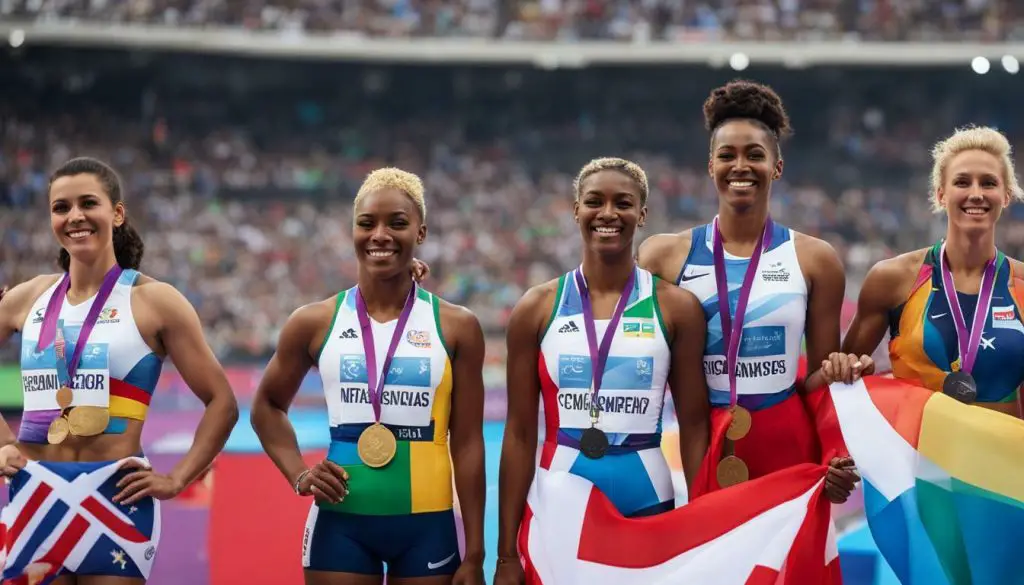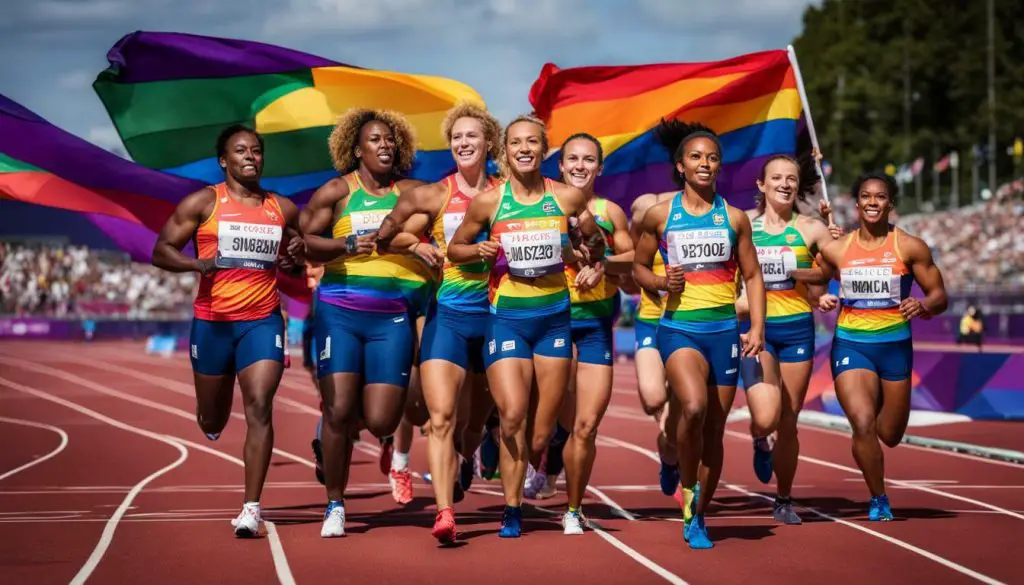Transgender athletes’ participation in the Olympics has been a subject of debate, with questions raised about their eligibility and the rules surrounding their inclusion. The Olympics, as a global sporting event, strive to create a fair and inclusive environment for all athletes, regardless of their gender identity.
Currently, there are regulations and guidelines in place for transgender athletes in Olympic competition. In track and field, transgender women who have transitioned from male to female and have undergone male puberty are banned from international competition. Athletes with differences in sex development (DSD), such as Caster Semenya and Christine Mboma, face certain regulations due to certain male traits caused by a medical condition. To be eligible, they must undergo hormone-suppressing treatment for six months before competing.
However, the International Olympic Committee (IOC) has recently announced a new framework that no longer requires athletes to modify their hormone levels to compete. This framework aims to ensure that athletes can participate in a safe and harassment-free environment that respects their needs and identities. While the new guidelines are not legally binding, they represent a significant step towards recognizing the importance of human rights and inclusivity in sports.
LGBTQ advocates have welcomed the IOC’s new guidelines, but the successful implementation of the framework depends on education and collaboration with national governing bodies and international federations. It is crucial to provide support and resources to create a level playing field for all athletes while ensuring a fair and competitive spirit in the Olympic Games.
Despite the ongoing debates and controversies, transgender athletes are allowed to compete in the Olympics. However, the eligibility criteria and regulations for their participation continue to be scrutinized and discussed. The aim is to strike a balance between inclusivity and maintaining the integrity of sports competitions.
Olympic Guidelines for Transgender Athletes
The International Olympic Committee has established guidelines that govern the inclusion of transgender athletes in the Olympics, setting specific rules and regulations to ensure fair competition. These guidelines aim to strike a balance between creating an inclusive environment for transgender athletes while also maintaining a level playing field for all participants.
Transgender women, who have transitioned from male to female, are eligible to compete in the Olympics but face certain restrictions. Under the current regulations, transgender women who have undergone male puberty are not allowed to compete in international track and field events. This criterion is based on the assumption that individuals who have experienced male puberty may have physical advantages, such as bone density and muscle mass, that could give them a competitive edge. The rationale behind this restriction is to ensure fair competition and protect the integrity of the sport.
Athletes with differences in sex development (DSD), such as Caster Semenya and Christine Mboma, who have certain male traits due to a medical condition, are also subject to regulations. To be eligible for competition, DSD athletes must now undergo hormone-suppressing treatment for six months prior to competing. This requirement aims to address any potential performance advantages resulting from naturally occurring higher testosterone levels.
| Transgender Athletes | DSD Athletes |
|---|---|
| Transgender women who have undergone male puberty are currently banned from international competition. | Athletes with DSD must undergo hormone-suppressing treatment for six months before competing to be eligible. |
| The IOC has recently announced a new framework that no longer requires hormone level modifications for transgender athletes to compete. | These guidelines aim to ensure that athletes can participate in a safe and harassment-free environment that respects their needs and identities. |
The new guidelines announced by the International Olympic Committee represent a significant step forward in recognizing the rights and inclusion of transgender athletes. By eliminating the requirement for hormone level modifications, the IOC acknowledges that transgender individuals can compete without an inherent advantage. These guidelines are not legally binding but serve as an authoritative framework to guide the eligibility of transgender athletes in Olympic competition.
LGBTQ advocates have welcomed the new guidelines, seeing them as a positive step towards creating a more inclusive and fair sports environment. However, the successful implementation of these guidelines depends on education and collaboration with national governing bodies and international federations. It will require ongoing efforts to ensure that transgender athletes have equal opportunities to compete while maintaining the integrity and fairness of the sports they participate in.
Recent Changes in Olympic Policies
In a significant step towards inclusivity, the International Olympic Committee has recently introduced a new framework that no longer demands hormone level modifications for transgender athletes participating in the Olympics.
This new framework aims to create a safe and harassment-free environment for all athletes, regardless of their gender identity. The guidelines recognize the importance of respecting the needs and identities of transgender individuals, allowing them to participate fully in Olympic competition.

Transgender athletes have long faced debates and controversies surrounding their eligibility criteria and regulations in sports. The new guidelines from the IOC represent a significant step forward in addressing these concerns, prioritizing human rights and inclusivity in sport.
However, the successful implementation of these guidelines relies heavily on collaboration and education with national governing bodies and international federations. It is crucial to ensure that transgender athletes are supported and provided with the necessary resources to compete on an equal playing field while also respecting the integrity of the sport.
Challenges and Opportunities
While the new framework is a positive development, it also brings challenges and opportunities. There may be resistance and misconceptions that need to be addressed, but it is also an opportunity to foster understanding and dismantle stereotypes.
| Challenge | Opportunity |
|---|---|
| Resistance from some individuals and organizations | Education and awareness campaigns can help dispel myths and promote inclusivity |
| Misconceptions about transgender athletes having a competitive advantage | Highlighting scientific research and testimonies from transgender athletes can help challenge these misconceptions |
| Lack of resources and support for transgender athletes | National governing bodies and international federations can work together to provide necessary resources, training, and support systems |
The inclusion of transgender athletes in the Olympics signifies a significant shift towards a more diverse and inclusive sporting world. By recognizing and celebrating the achievements of transgender athletes, we can continue to pave the way for a future where everyone, regardless of their gender identity, has the opportunity to compete and excel in their chosen sports.
Impact and Challenges of the New Guidelines
The new guidelines introduced by the International Olympic Committee (IOC) mark an important milestone in recognizing the rights of transgender athletes, but their practical implementation depends on collaboration with national governing bodies and international federations. The IOC’s framework aims to create a safe and inclusive environment for all athletes, regardless of their gender identity. LGBTQ advocates have welcomed these new guidelines, considering them a step forward in promoting equality and fairness in sports.
However, the implementation of these guidelines poses certain challenges. Education and collaboration with national governing bodies and international federations are crucial for the successful integration of transgender athletes in sports. These organizations need to develop comprehensive policies and procedures to ensure that transgender athletes are treated with respect and are provided with equal opportunities to compete.
One of the challenges is determining the eligibility criteria for transgender athletes. While the new guidelines eliminate the requirement for athletes to modify their hormone levels, there are still debates surrounding the potential advantages that transgender women may have over cisgender women. Striking the right balance between inclusion and fairness remains a challenge that needs to be addressed.
Another challenge is overcoming societal prejudices and discrimination. Transgender athletes often face prejudice and bigotry, both from within the sporting community and society at large. Creating a supportive and accepting environment requires raising awareness, combating discrimination, and fostering a culture of inclusivity and respect.

In conclusion, the new guidelines introduced by the IOC represent a significant step towards recognizing and protecting the rights of transgender athletes in the Olympics. However, their successful implementation depends on the collaboration and efforts of national governing bodies and international federations. Addressing the challenges of eligibility criteria and overcoming societal prejudices are key to ensuring that transgender athletes can compete in an inclusive and fair sports environment.
Conclusion
While transgender athletes are allowed to compete in the Olympics, the conversations around their eligibility criteria and regulations continue to spark debates and controversies. In track and field, transgender women who have undergone male puberty are currently banned from international competition. Athletes with differences in sex development (DSD) also face regulations and must undergo hormone-suppressing treatment for six months before competing. However, the International Olympic Committee (IOC) has recently announced a new framework that eliminates the requirement for athletes to modify their hormone levels to participate.
The new guidelines, although not legally binding, aim to create a safe and inclusive environment for all athletes. The IOC’s framework is seen as a significant step towards centering human rights as the foundation of sport and recognizing the participation of transgender and intersex athletes without an inherent advantage. LGBTQ advocates have welcomed these changes, as they represent a commitment to inclusivity and fairness.
Implementing the new framework successfully will require education and collaboration with national governing bodies and international federations. It is crucial to ensure that the guidelines are understood, respected, and followed across all levels of sports. While there may be ongoing concerns and challenges, the goal is to create a more equal playing field and respect the needs and identities of all athletes.
As we move forward, the eligibility criteria and regulations for transgender athletes in Olympic competition will likely continue to evolve. It is essential to engage in open and respectful dialogue to address any concerns and find solutions that balance inclusivity, fairness, and the spirit of competition. The goal is to create an environment where everyone can participate, regardless of their gender identity, while maintaining the integrity of the sport and upholding the principles of fair play.
FAQ
Are transgender athletes allowed to compete in the Olympics?
Yes, transgender athletes are allowed to compete in the Olympics. However, there are specific regulations and guidelines in place to ensure fair competition and inclusion.
What are the current guidelines for transgender athletes in the Olympics?
The International Olympic Committee (IOC) has regulations that ban transgender women who have undergone male puberty from competing in track and field. Athletes with differences in sex development (DSD) are also subject to regulations and may need to undergo hormone-suppressing treatment before competing.
Has there been any recent changes in Olympic policies regarding transgender athletes?
Yes, the IOC recently announced a new framework that eliminates the requirement for athletes to modify their hormone levels to compete. This aims to ensure a safe and harassment-free environment that respects the needs and identities of transgender athletes.
What impact and challenges come with the implementation of the new guidelines?
The new guidelines are seen as a significant step towards centering human rights as the foundation of sport and recognizing the participation of transgender and intersex athletes without an inherent advantage. However, successfully implementing the framework requires education and collaboration with national governing bodies and international federations.
What is the conclusion regarding the eligibility of transgender athletes in the Olympics?
The eligibility criteria and regulations for transgender athletes in Olympic competition continue to be a subject of debate and controversy. While transgender athletes are allowed to compete, ongoing discussions and advancements are needed to create a more inclusive and fair sports environment.